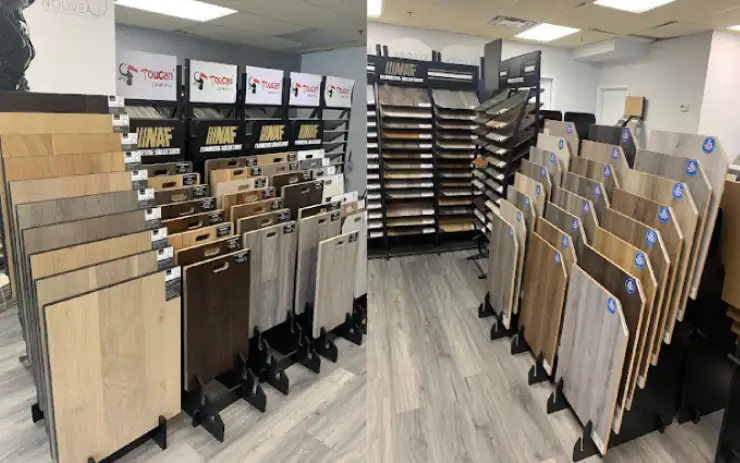The Ultimate Flooring Store Shopping Guide: Everything You Need to Know

Choosing the right flooring for your home or business is a significant decision. It impacts not only the aesthetics but also the functionality and maintenance of your space. Whether you’re renovating or building from scratch, navigating the myriad of options available in flooring stores can be overwhelming. This guide aims to simplify the process, providing you with essential information and tips to make an informed decision.
Types of Flooring
Understanding the various types of flooring is the first step in your shopping journey. Here’s an overview of the most popular options:
Hardwood
Pros:
- Timeless and elegant appearance.
- Durable and can be refinished multiple times.
- Adds value to your home.
Cons:
- Expensive compared to other options.
- Prone to scratches and water damage.
- Requires regular maintenance.
Best for: Living rooms, bedrooms, and dining areas.
Laminate
Pros:
- Cost-effective alternative to hardwood.
- Resistant to scratches and fading.
- Easy to install.
Cons:
- Can’t be refinished; needs replacement if damaged.
- Less luxurious feel compared to real wood.
- Sensitive to moisture.
Best for: Living rooms, bedrooms, and hallways.
Vinyl
Pros:
- Highly durable and water-resistant.
- Available in various styles, including those that mimic wood and stone.
- Affordable and low maintenance.
Cons:
- Can be difficult to repair if damaged.
- May off-gas chemicals initially.
- Less luxurious than natural materials.
Best for: Kitchens, bathrooms, and basements.
Tile
Pros:
- Extremely durable and water-resistant.
- Wide variety of styles and colors.
- Easy to clean.
Cons:
- Cold and hard underfoot.
- Can be slippery when wet.
- More challenging to install and replace.
Best for: Bathrooms, kitchens, and entryways.
Carpet
Pros:
- Soft and comfortable underfoot.
- Provides insulation and noise reduction.
- Available in many colors and textures.
Cons:
- Stains easily and can harbor allergens.
- Requires regular cleaning.
- Less durable than hard flooring options.
Best for: Bedrooms, living rooms, and family rooms.
Factors to Consider
When selecting flooring, it’s essential to consider various factors beyond just the look and feel. Here are key aspects to keep in mind:
Budget
Your budget will significantly influence your choice of flooring. Hardwood and natural stone tend to be more expensive, while laminate, vinyl, and carpet are generally more affordable. Remember to factor in the cost of installation, underlayment, and any necessary maintenance or repairs.
Durability
Consider the amount of foot traffic in the area where the flooring will be installed. High-traffic areas like hallways and kitchens require more durable materials, whereas low-traffic areas like bedrooms can accommodate less robust options.
Maintenance
Different flooring types require varying levels of maintenance. Hardwood needs periodic refinishing, carpet requires regular vacuuming and deep cleaning, while tile and vinyl are relatively low maintenance.
Aesthetic Appeal
Your flooring should complement the overall design and decor of your space. Consider the color, texture, and style that will best enhance your interior.
Installation
Some flooring types are easier to install than others. Laminate and vinyl often feature click-and-lock systems suitable for DIY projects, while hardwood, tile, and carpet typically require professional installation.
Environmental Impact
If sustainability is important to you, consider eco-friendly flooring options such as bamboo, cork, or reclaimed wood. Look for products with certifications like FSC (Forest Stewardship Council) or low VOC (Volatile Organic Compounds) emissions.
Shopping Tips
Navigating the selection process can be daunting. Here are some practical tips to streamline your shopping experience:
Research and Compare
Before heading to a flooring store, do your homework. Research different flooring types, read reviews, and compare prices online. This will give you a clearer idea of what to expect and help you make informed decisions.
Visit Multiple Stores
Don’t settle for the first store you visit. Explore multiple flooring stores to compare options, prices, and customer service. Some stores may offer better deals or a wider variety of products.
Ask for Samples
Most flooring stores provide samples that you can take home. This allows you to see how different options look in your space and under your lighting conditions. It’s a crucial step to avoid buyer’s remorse.
Check Warranty and Return Policy
Review the warranty and return policy for the flooring you’re considering. A good warranty can provide peace of mind, and a flexible return policy can save you from being stuck with an unsuitable product.
Professional Consultation
Many flooring stores offer free consultations with flooring experts. Take advantage of this service to get personalized advice based on your specific needs and preferences.
Inquire About Installation
If you’re not planning a DIY installation, ask about the store’s installation services. Some stores offer professional installation at a discounted rate when you purchase flooring from them.
Common Mistakes to Avoid
Avoid these common pitfalls to ensure a smooth flooring shopping experience:
Ignoring Subfloor Condition
The condition of your subfloor can affect the performance and longevity of your new flooring. Ensure it is clean, level, and dry before installation.
Overlooking Lifestyle Needs
Your lifestyle should influence your flooring choice. For example, if you have pets or children, opt for durable and easy-to-clean flooring.
Skimping on Quality
While it’s tempting to choose the cheapest option, investing in high-quality flooring can save you money in the long run by reducing repair and replacement costs.
Forgetting About Acoustics
Consider how your flooring will affect the acoustics of your space. Hard surfaces like tile and hardwood can amplify noise, while carpet and cork can help absorb sound.
Not Considering Future Plans
Think about your long-term plans. If you’re planning to sell your home in the near future, choose flooring that appeals to a broad range of buyers and adds value to your property.
Conclusion
Choosing the right flooring is a crucial decision that impacts the look, feel, and functionality of your space. By understanding the different types of flooring, considering key factors, and following practical shopping tips, you can make an informed choice that meets your needs and enhances your home or business. Remember to take your time, do thorough research, and don’t hesitate to seek professional advice. With the right approach, you’ll find the perfect flooring that combines beauty, durability, and practicality.


